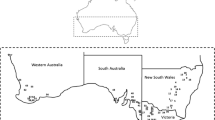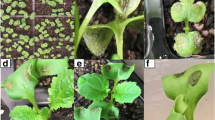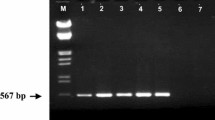Abstract
Brassica juncea (Indian mustard) lines from diverse geographical locations around the world and from Australian breeding programs were screened for resistance to the blackleg fungus, Leptosphaeria maculans, in both glasshouse and field trials. The five Australian L. maculans isolates used in glasshouse trials could be classified into two groups; those that attacked all B. juncea lines, and those that attacked none. All these isolates caused lesions on cotyledons of B. napus cultivars including Westar, Glacier and Quinta, suggesting that they are in Pathogenicity Group 4 as described by Koch et al. (1991). The two isolates that attacked B. juncea also attacked B. napus lines to a similar extent, but did not attack the two B. carinata lines tested. Brassica lines were sown in a blackleg disease nursery at Lake Bolac, Victoria, Australia, and five indicators of blackleg disease were measured (survival rate, disease rating, disease incidence, external and internal lesion length). All 92 B. juncea lines developed blackleg symptoms. Although they displayed a high disease incidence in the field, almost all of the B. juncea lines were more blackleg-resistant than a B. napus cultivar, Dunkeld, which is amongst the most resistant cultivars in commercial production in Australia. Four B. carinata lines were more resistant than any of the B. juncea lines, suggesting that this species may be a useful source of blackleg resistance in B. napus breeding programs.
Similar content being viewed by others
References
Ballinger DJ and Salisbury PA (1996) Seedling and adult plant evaluation of race variability in Leptosphaeria maculanson Brassicaspecies in Australia. Aust J Exp Agric 36: 485-488
Chen CY and Howlett BJ (1996) Rapid necrosis of guard cells is associated with the arrest of fungal growth in leaves of Indian mustard (Brassica juncea) inoculated with avirulent isolates of Leptosphaeria maculans. Physiol Mol Plant Path 48: 73-81
Chen CY, Plummer KM and Howlett BJ (1996) Ability of an Leptosphaeria maculansisolate to form stem cankers on Indian mustard segregates as a single locus. Eur J Plant Path 102: 349–352
Chevre AM, Eber F, This P, Barret P, Tanguy X, Brun H, Delseny M and Renard M (1996) Characterisation of Brassica nigrachromosomes and of blackleg resistance in B. napus-B. nigraaddition lines. Plant Breeding 115: 113-116
Chevre AM, Barret P, Eber F, Dupuy P, Brun H, Tanguy X and Renard M(1997) Selection of stable Brassica napus-B. juncearecombinant lines resistant to blackleg (Leptosphaeria maculans)1. Selection of molecular markers, chromosomal and genomic origin of the introgression. Theor Appl Genet 95: 1104-1111
Cohen BM and Knowles PF (1983) Evaluation of Brassicaspecies in California. Proceedings of Sixth International Rapeseed Congress, Paris, France pp. 282-285
Gugel RK, Seguin-Swartz G and Petrie GA (1990) Pathogenicity of three isolates of Leptosphaeria maculanson Brassicaspecies and other crucifers. Can J Plant Path 12: 75-82
Hammond KE, Lewis BG and Musa TM (1985) A systemic pathway in the infection of oilseed rape plants by Leptosphaeria maculans.Plant Path 34: 557-565
Johnson RD and Lewis BG (1994) Variation in host range, systemic infection and epidemiology of Leptosphaeria maculans. Plant Path 43: 269-277
Keri M, van den Berg CGJ, McVetty PBE and Rimmer SR (1997) Inheritance of resistance to Leptosphaeria maculansin Brassica juncea. Phytopath 87: 594-598
Koch E, Song K, Osborn TC and Williams PH (1991) Relationship between pathogenicity and phylogeny based on restriction fragment length polymorphism in Leptosphaeria maculans. Mol Plant Microbe Inter 4: 341-349
Kutcher HR, van den Berg CGJ and Rimmer SR (1993) Variation in pathogenicity of Leptosphaeria maculanson Brassica spp. based on cotyledon and stem reactions. Can J Plant Path 15: 253-258
McCune B and Mefford MJ (1997) PC-ORD multivariate analysis of ecological data. Version 3.0 MjM, Software Design, Gleneden Beach, Oregon, USA
Pang ECK and Halloran GM (1996) The genetics of adult-plant blackleg (Leptosphaeria maculans) resistance from Brassica junceain B. napus. Theor Appl Genet 92: 382-387
Plummer KM, Dunse K and Howlett BJ (1994) Non-aggressive strains of the blackleg fungus Leptosphaeria maculansare present in Australia and can be distinguished from aggressive strains by molecular analysis. Aust J Bot 42: 1-8
Rimmer SR and van den Berg CGJ (1992) Resistance of oilseed Brassicaspp. to blackleg caused by Leptosphaeria maculans. Can J Plant Path 14: 56-66
Roy NN (1984) Interspecific transfer of Brassica juncea-type high blackleg resistance to Brassica napus. Euphytica 33: 295-303
Salisbury PA, Ballinger DJ, Wratten N, Plummer KM and Howlett BJ (1995) Blackleg disease on oilseed Brassicasin Australia - a Review. Aust J Exp Agric 35: 665-674
U N (1935) Genome analysis in Brassicawith special reference to the experimental formation of Brassica napusand peculiar mode of fertilisation. Jap J Botany 7: 389-452
Williams PH (1992) Biology of Leptosphaeria maculans. Can J Plant Path 14: 30-35
Author information
Authors and Affiliations
Rights and permissions
About this article
Cite this article
Purwantara, A., Salisbury, P.A., Burton, W.A. et al. Reaction of Brassica juncea (Indian Mustard) Lines to Australian Isolates of Leptosphaeria maculans under Glasshouse and Field Conditions. European Journal of Plant Pathology 104, 895–902 (1998). https://doi.org/10.1023/A:1008609131695
Issue Date:
DOI: https://doi.org/10.1023/A:1008609131695




